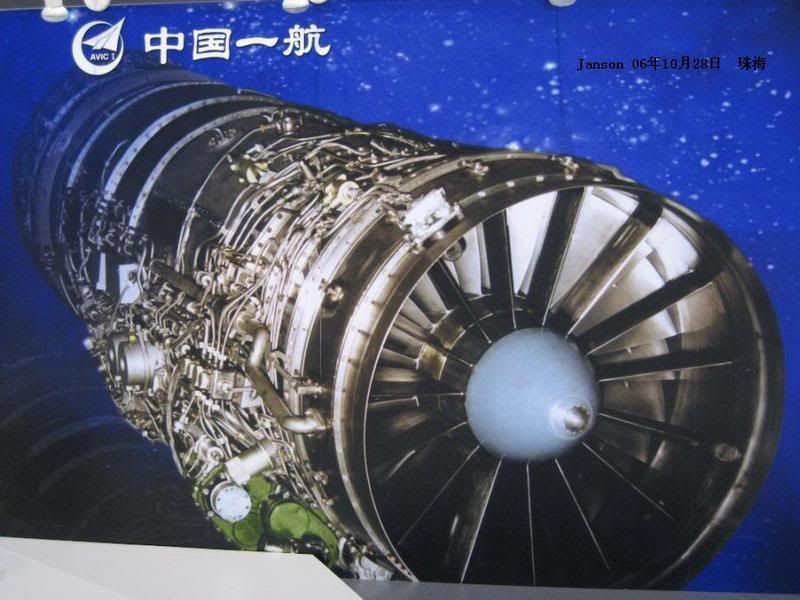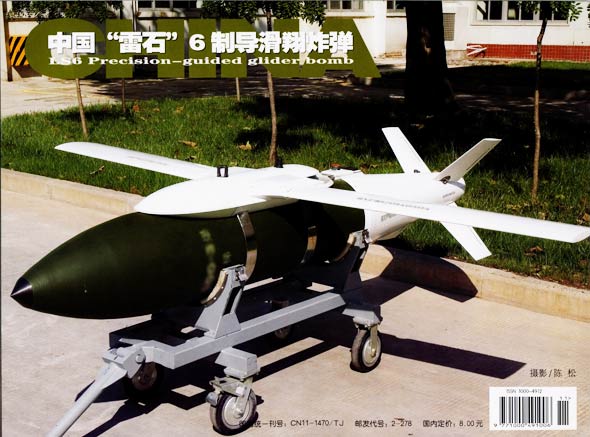6th PRC Aviation & Aerospace Exh
-
The PRC military technology is improving rapidly...maybe one day we might have to learn from them...

-
-
What I impress the most is the Chinese made F110/F100 level high T/W turbofan engine released in the Zhuhai airshow. That makes the Chinese the 5th and only Asian country which can independently make such advanced aviation engine in the world ( after US/UK/Russia/France).
The induction of the “Taihan” turbofan engine into PLAAF means the Chinese now are capable to manufacture 100% western 3G fighter jets from Radar/Avionics to the most difficult part: the engine.
The Chinese TV report ( Video clip) on the engine and Chinese made flankers powered by them:
http://www.youtube.com/watch?v=x37FZef0nqs
The image of the WS-10A “Taihan” turbofan engine shown in zhuhai ( From another forum )
-
totally cool
-
well they waited a long time for it
-
American magazine “Aviation Week & Space Technology” ( AWST) carried a lengthy report on the Zhuhai Airshow, especially the indigenous J11B ( Chinese Flanker ) & WS-10A turbofan engine
Chinese J-11B Presages Quiet Military Revolution
to be continued...
http://www.aviationnow.com/avnow/news/channel_awst_story.jsp?id=news/aw110606p2.xml
By Douglas Barrie
11/05/2006 09:17:03 PM
POWER PLAY
China is in the midst of a critical period of testing an "indigenous" version of the Russian Su-27 Flanker, known as the J-11B, with propulsion, radar and weapons system integration underway.
The effort is emblematic of Beijing's efforts to recast its capabilities for the 21st century as its military and associated defense-aerospace sector undergoes its own revolution in military affairs.
The development of the J-11B, if successful, will mark a notable change in capability--not only for key elements of the country's defense industrial base, but also for the People's Liberation Army Air Force (PLAAF).
The Chinese military is recalibrating the balance of quantity and quality in favor of the latter, as a guarantor of a decisive military edge and the ability to project power regionally. At the same time, the nature of the relationship between Beijing and Moscow may be subtly changing, reflecting China's growing confidence in its own capabilities.
Alongside key elements on the J-11B, Chinese industry is beginning to produce a gamut of capable guided weapons, both tactical and strategic, including satellite-guided precision systems. The emergence of unmanned platforms is also gaining the attention of Beijing.
The nationally developed systems now in various stages of the J-11B test program potentially provide performance improvements over the various Su-27 models now in PLAAF service. -
Air Show China, held here Oct. 31-Nov. 5, included the first official detail about the Shenyang Tai Hang engine. This turbofan powerplant is being developed for the Flanker, and is also sometimes referred to as the WS-10A. A handful of J-11B airframes are now likely being used for development testing, including at least one J-11B engine-integration aircraft.
Beijing and Moscow first agreed on the Flanker sale in 1991, with a license production contract signed in 1996. The Flanker has given China its most capable fighter aircraft while also providing a vehicle for its industry to gain knowledge of fourth-generation fighter manufacturing. The first kit-built J-11A was completed in 1998. The J-11A still uses Russian engines, radar and weaponry.
Design and development of the Tai Hang has been underway for nearly two decades, says one senior Chinese aero-engine executive. He admits the program has proved challenging: "We hit difficulties in developing the engine."
Chinese industry executives attending the show remain reticent to discuss the J-11B program. The executive would say only that the Tai Hang has "similar applications to the Al-31 [the present Su-27 engine]. It's of a similar thrust and is of the same technology generation." The J-11B program also includes the integration of Chinese-developed planar array pulse-Doppler radar replacing the Russian N-001 cassegrain radar, at least two versions of which are fielded by the PLAAF. An image of a J-11B, still in its primer (see top photo on p. 27), appears to show the aircraft fitted with a different radome to the basic Su-27. Given the available space for a flat-plate antenna, this would offer a performance improvement over the N-0001.
Also associated with the J-11B is the Luoyang PL-12 active radar-guided medium-range air-to-air missile. While the Chinese air force already has the Russian R-77 (AA-12 Adder) in service with the Su-27, the PL-12 offers a big performance increase over the present export standard of the Vympel R-77. Officials from the company were unable to discuss the PL-12 project.
The initial development test-firing program for the overall PL-12 program now appears complete, with the missile at least close to service entry. It was integrated first on the J-8II for the development program. Trials of the PL-12 on the Chengdu J-10 also have been carried out.
The PL-12 does benefit from Russian technology, with the seeker and inertial guidance system provided by Moscow. A variant of the Agat 9B-1103M radar seeker is the most likely candidate for the missile. This seeker was intended initially for an improved version of the R-77, but appears to have been sold to China first.
The PLAAF currently has the capability for two-target engagement using the Su-27, R-77 combination. Successful integration of the PL-12 on the J-11B would likely provide a genuine multitarget capability and give the PLAAF a more capable air superiority aircraft.
The country is also moving to fill gaps in its tactical weapons capability, and to bolster its ability to support combat aircraft export proposals with credible guided-weapons packages. The show included the presentation of several previously unseen air-launched tactical systems. Luoyang showed the LT-2 laser-guided bomb, along with the LS-6 precision-guided glide bomb (middle photo). Rival China Aerospace and Technology Corp. unveiled its FT-1 and FT-3 satellite-guided weapons family. Both are aimed at potential exports of the FC-1 light fighter, including Pakistan, and likely national requirements.
Meanwhile, China Aerospace Science and Industry Corp. (Casic) showed the C-704 antiship missile (bottom photo), along with the C-802KD air-to-surface version of the C-802 antiship weapon.
The LT-2 has been in service with the Chinese air force "for more than three years," says a Luoyang executive. The 500-kg.-class (1,100-lb.) weapon resembles the Russian KAB family. The official suggested that the laser-guided bomb has a range of up to 20 km. (12.4 mi.) from high altitude, with an average accuracy of about 2 meters (6.5 ft.).
The LS-6 appears, in effect, a successor system, with a family of weapons planned. The official says "about a dozen" launch tests of the LS-6 precision bomb kit have been carried out using a Shenyang J-8II as the test aircraft. The program was begun in 2003, with testing now complete.
He identifies the JF-17--the Pakistan air force designation for the Chengdu FC-1 now in development--as the next intended aircraft for integration of the weapon. Guidance is provided by an inertial package coupled with satellite navigation. The official says the weapons family will be capable of using three systems--the U.S. GPS, the Russian Glonass and China's own Beidou system. The architecture for this system eventually foresees using five satellites in geosynchronous orbit (GEO) and up to 30 non-GEO platforms.
The 500-kg. LS-6 has a maximum launch range of 60 km. from medium altitude. A 1,000-kg. kit has also been considered, although this requires a larger wing. A 250-kg. variant is in the pipeline as well. Also under study is the addition of a laser seeker.
The two weapons shown by Casic cover the 250-kg. and 500-kg. class. The FT-1 bears a resemblance to the U.S. Joint Direct Attack Munition. Development began in 2001, according to a company executive. Tests have been carried out from a Xian JH-7. Range of the FT-1 is given as up to 18 km., depending on the release altitude and aircraft speed, with an accuracy of "30 meters, or less." Casic subsidiary China National Precision Machinery Import & Export Corp. is responsible for the C-704. At least a small batch of the antiship missile has been produced.
The design is strongly reminiscent of the Hongdu JJ/TL-6 antiship missile, although dimensions and performance figures for the two vary slightly. Data provided for the C-704 give the monopulse active-radar-guided missile a maximum engagement range of 35 km.
The company is also offering a further variant of its C-802 antiship missile. The air-launched C-802KD is claimed to be capable of engaging ships in harbor or some fixed land targets. Given that the missile is fitted with a radar seeker only, land targets would need to provide a high radar contrast.
An electro-optically guided medium-size air-launched weapon in a similar class to the C-802 is under development in China. This program almost certainly corresponds to the KD-88 designation.
The first indications of a measured shift in Sino-Russian relations could be detected in the outcome of the ongoing "push and shove" between Beijing and Moscow over the provision of a Russian engine for the FC-1 light fighter. The aircraft is a joint development between China and Pakistan.
Chinese and Russian aerospace executives are maintaining China's FC-1 light fighter will be provided to Pakistan with a Russian engine, though this is still pending political approval from Moscow. The Russian government has yet to approve the release, with suggestions that Moscow might nix a deal to avoid jeopardizing sales to India.




